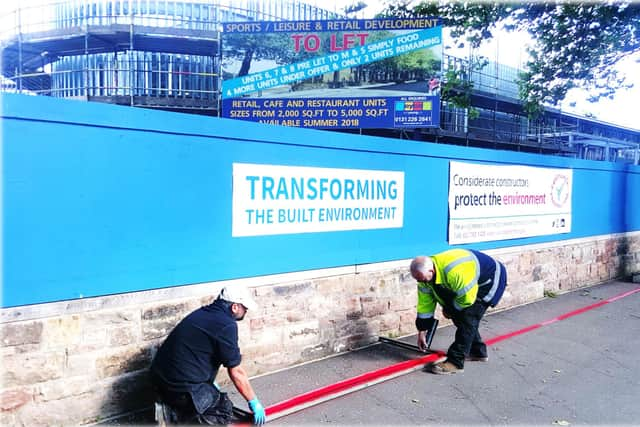Now there's a film to explain the row over the 'ransom strip' at Edinburgh's Accies development
and live on Freeview channel 276
The row over the 2ft wide strip in front of the shops which form part of the development on Comely Bank Road has been going on since before work on the project began.
The Evening News revealed in 2016 how the £16m scheme, including a 2500-seat stand and hospitality suite, faced problems because of the narrow piece of land that used to lie directly under a now-demolished wall and could potentially be used to block easy access to the shops. It was owned by the Grange Cricket and Sports Club and valued at £1 million.
Advertisement
Hide AdAdvertisement
Hide AdDouglas Lowe, who led a consortium of senior club members which bought the land from the Grange in 2017 for a reported £12,500, is appealing against a court ruling earlier this year that the strip was legally part of the roadway, which meant it could not be used as a ransom strip.


Now Mr Lowe has commissioned Edinburgh-based professional animator Colin Perry to make a four-minute video, using a model to explain the complex arguments in a simple format.
The story goes back to 1911 when the Accies site was owned by the Grange and Academical Trust. Because the wall separating the land from the road was only 4ft high, the trust put up advertising hoardings to prevent people watching sport for free. When residents and the council complained about the hoardings, the trust agreed to give up a 6ft strip of land to allow the pavement to be widened if the council built a higher wall and accepted responsibility for maintaining it.
But the video explains the new wall, put up in 1912, was built further into the site than agreed, adding an extra foot to the pavement. It says the 6ft strip given up did not include the land that was built on or the wall itself; and even if the wall had been built in the right place, the land it occupied would still have been part of the trust’s property.
Advertisement
Hide AdAdvertisement
Hide AdMr Lowe believes the film can help people to see the issues more clearly. “People have said to me 'If you'd told us that to begin with we'd have understood it all'.”
But he said Lady Wolffe, the judge who ruled the land was part of the roadway, had not focused on these arguments and he believes this could be a point where the appeal judges will disagree with her finding.
“The interpretation she put on the contract was that the extent of the ground to be given up was to be determined by where the wall was eventually built and it didn’t matter it said 6ft – even though 6ft was clearly stated. Normally if there is any uncertainty, a contract will say 6ft ‘or thereby’ but in this case it was just 6ft.”
He said if he wonthe case he would be in a position to sell or lease the strip to the developers. “It's a simple commercial arrangement so far as I’m concerned.”
Advertisement
Hide AdAdvertisement
Hide AdAnd he has previously said he would use the money to fund a new sports hall at the next-door Grange Club.
A message from the Editor:
Thank you for reading this article. We're more reliant on your support than ever as the shift in consumer habits brought about by coronavirus impacts our advertisers.
If you haven't already, please consider supporting our trusted, fact-checked journalism by taking out a digital subscription.
Comment Guidelines
National World encourages reader discussion on our stories. User feedback, insights and back-and-forth exchanges add a rich layer of context to reporting. Please review our Community Guidelines before commenting.